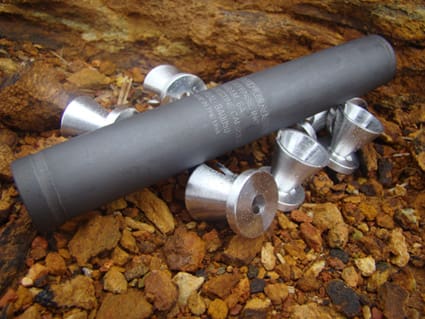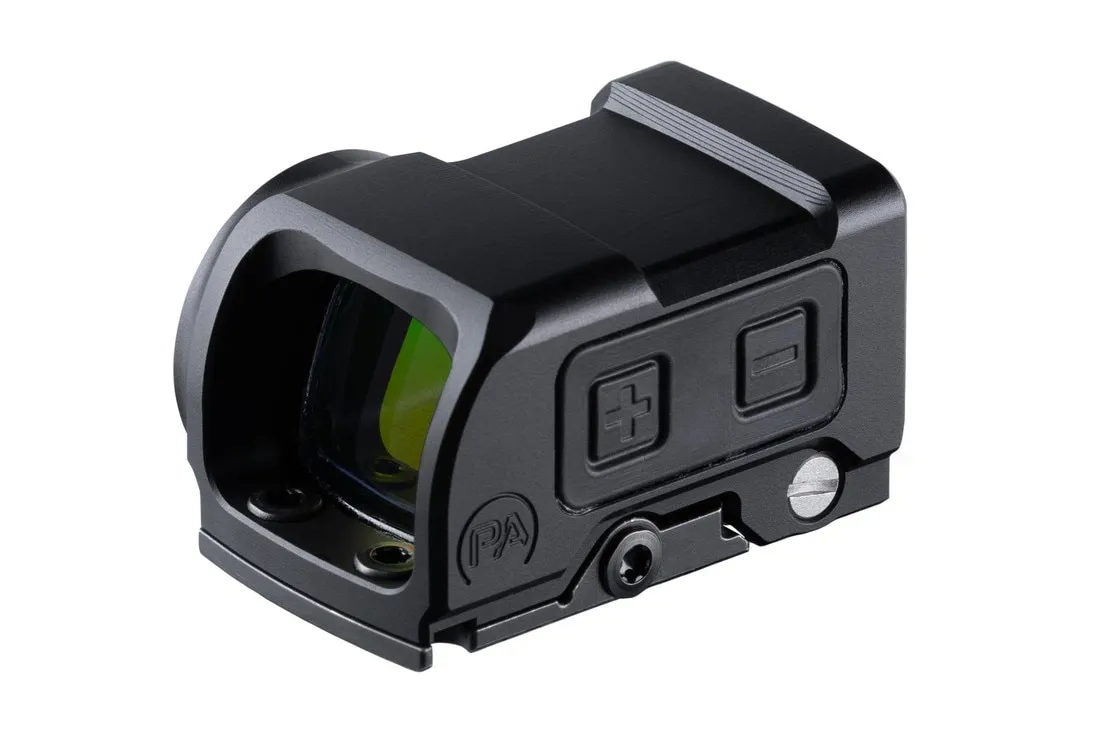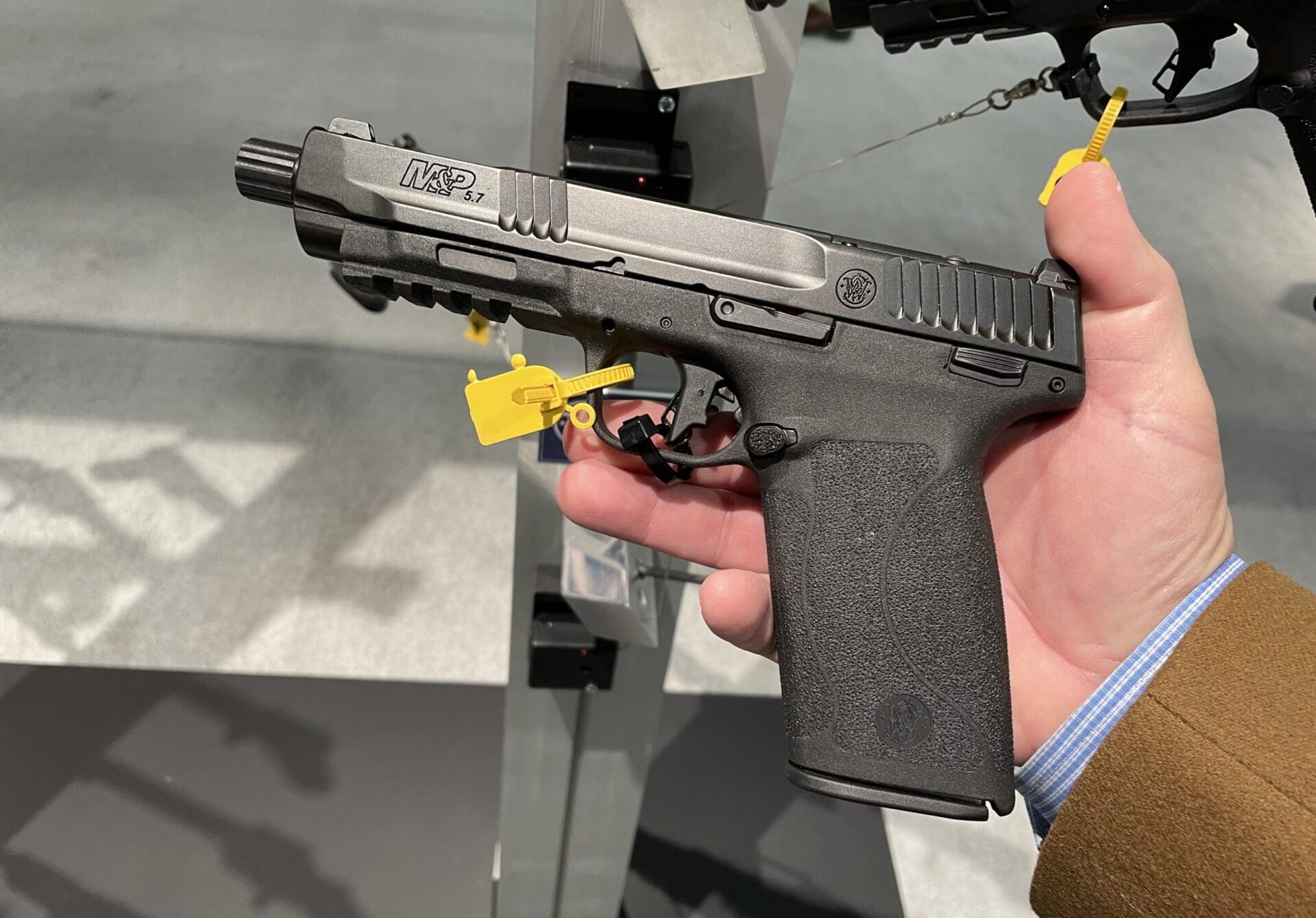Smith & Wesson is bringing back the well-loved, if not outrageously over-engineered, Model 66 ‘Combat Magnum’ for 2014. The original Model 66 has been out of production for nine years, which apparently has whetted shooters’ appetites enough to justify a new production run . . .
Essentially a stainless iteration of the .357 Magnum Model 19, the K-Frame 66 was in steady production from 1970 until 2005. Smith enthusiasts believe the Model 19/66 trigger to be lighter and smoother than the later Model 686 trigger, because the latter revolver’s oversized cylinder simply requires too much effort to spin in the frame. I’ve always considered the 19/66 to be a more attractive gun than the (still handsome) 586/686 because of its slightly more rounded lines and recessed cylinder heads.
 The 19/66 design had a reputation for wearing itself loose if you fed it too many full-power (as in: hotrod 125-grain) .357 pills. Frames would sometimes stretch and cause the cylinder timing to wander, and some guns showed significant forcing cone damage as well. Whether the Model 66 Revisited will have a stronger stomach has yet to be determined. Some press reports are hinting that the new Model 66 is ‘strong where the earlier version was weak’ but I haven’t seen Smith & Wesson make any particular representations to that effect.
The 19/66 design had a reputation for wearing itself loose if you fed it too many full-power (as in: hotrod 125-grain) .357 pills. Frames would sometimes stretch and cause the cylinder timing to wander, and some guns showed significant forcing cone damage as well. Whether the Model 66 Revisited will have a stronger stomach has yet to be determined. Some press reports are hinting that the new Model 66 is ‘strong where the earlier version was weak’ but I haven’t seen Smith & Wesson make any particular representations to that effect.
Sixguns are not in vogue these days, but a medium-frame .357 is an excellent handgun for beginners because of its safety, reliability and versatility. And if you’re accustomed to the gritty go-pedals of Glocks and M&Ps, the double-action K-Frame will probably have the sweetest trigger pull you’ve ever felt. 37-ounce handguns have a way of taming recoil; .38 +P loads barely kick at all, and even the hottest magnums will produce recoil and muzzle snap that’s more manageable than the current crop of micronines.
Once you remove the dastardly ‘safety’ lock, there’s almost nothing you can do to make a K-Frame not function properly. The manual of arms is shockingly simple: load it with any .38 or .357 ammo that’s less than 20 years old and hasn’t been stored underwater, aim it and squeeze the trigger. Lather, rinse and repeat as needed.
MSRP for this 1970s wheelgun icon is $850, but the street price is at least $100 below that. Of course, you’ll probably turn right around and spend that C-note having your gunsmith remove the ‘safety’ lock.








“In the city, police are generally just four minutes away, Suhr said.”
I guess four minutes of being assaulted is ok, as far as the chief is concerned.
Weren’t police four minutes away at Sandy Hook? The police protection didn’t work out so well for 26 people there.
“Safety” lock…echh. Were I in the market, I’d simply buy a cherry used Model 66. Shopping around, you should be able to get one in the neighborhood of $650 or so.
In the meantime, since I have the day off today I may just have to take out the fairly nice S&W 1937 Brazilian contract .45 ACP revolver I recently acquired! No #$@&%*! “safety” lock on a classic like that…!
🙂
Even those old boys need the exercise. Those are great pistols. Stout as an old truck.
Glad I kept my old 66 w/4″ barrel (duty gun) after reading all these. Was a gift from ex-father-in-law when I became a police officer. Nice gun after I had the trigger pull reduced a little, poly grips.
Also own a Glock 26 & Glock 30, for CLP.
He doesn’t look like he’s having fun anymore.
Why must they still include that ugly safety lock? There’s no reason for it. As excited as I am for this, I’d rather pay MSRP for a used Model 19/66 without the damn lock.
Hate to be the one to break it to you, but the 19-4 was the last of the model 19’s with a recessed cylinder. Not sure about the 66.
San Franciscans who want a concealed carry permit are required to submit a lengthy questionnaire, a psychological evaluation, a shooting test and an interview with Suhr.
I don’t think he’d enjoy having an interview with me, as when he asked why I thought I should be able to carry a firearm I’d simply pull out my pocket constitution rather than beg, hat in hand, for the right.
Were I to live in San Francisco (shudder), the phrase about the advantages of being tried by 12 vs. carried by 6 comes to mind…
“Swiney” is still on his re-election high. Unfortunately, even though I DIDN’T vote for him he managed to stick around. Maybe it was his use of his disabled daughter in commercials that won hearts and minds. I found that part rather disgusting as my oldest is autistic. Never thought about an actual carry gun here. Better start the paperwork now!
These should be the simplest way to get them off their holier than thou soap box. Relying on you how did all these crimes still occur?
http://www.city-data.com/crime/crime-San-Francisco-California.html
The lesson is simple:
1. Call 911 only if you can leave before they show up.
2. NEVER talk to a cop.
I agree that trying to enforce the law at this point will be the harbinger of civil war (though “war” denotes a scale which I don’t think we’ll see). I do NOT want to see a civil war kick off over gun rights, but at the same time a part of me wants to see them try to enforce the law, see the people’s reaction, and quit beating around the bush on the issue of RKBA.
Well the way MD was able to get what they wanted was all the agreeing folks after 30 days got a voter card. Then moved on to the next state. I am sure some would open there home to us for this very good cause. All you need is a letter stating your a renter. Just saying
“Authorities should use the background check database as a way to find assault weapon purchasers who might not have registered those guns in compliance with the new law.”
Background checks = registration = confiscation.
It’s nice of them to finally admit it. In writing.
Of course he wants to convince people to rely on the cops. If people figure out that they can do things themselves, he’s out of a job.
How are they going to enforce it? Do they have a list of people that have unregistered ‘assault weapons’?
I wonder how many people in CT recently purchased hammerhead grips or those really odd-looking pistol-grip-stocks.
I wonder how many of those that did have them sitting in the boxes, unopened.
And in the true liberal type of “tolerance” they are not allowing any comments related to this story in their piece of crap Pravda. I’m so glad I moved out of there
Or you could just buy a Ruger Six series gun (used) or a GP100 new and not have any of those problems. However I did buy a 4″ GP100 recently that would not hit the broad side of a barn. My Security 6, GP100 six” and SP101 are plenty accurate and I would bet my life on any of the 3. Years ago I had an old model 66 police trade in that I’m sure had never been fired except to qualify annually. I did not know about it’s supposed design weaknesses. Glad I got rid of it.
“The real owners [of America] are the big wealthy business interests that control things and make all the important decisions. Forget the politicians, they’re an irrelevancy. The politicians are put there to give you the idea that you have freedom of choice. You don’t. You have no choice. You have owners. They own you. They own everything. They own all the important land. They own and control the corporations. They’ve long since bought and paid for the Senate, the Congress, the statehouses, the city halls. They’ve got the judges in their back pockets. And they own all the big media companies, so that they control just about all of the news and information you hear. They’ve got you by the balls. They spend billions of dollars every year lobbying lobbying to get what they want. Well, we know what they want; they want more for themselves and less for everybody else.”
“But I’ll tell you what they don’t want. They don’t want a population of citizens capable of critical thinking. They don’t want well-informed, well-educated people capable of critical thinking. They’re not interested in that. That doesn’t help them. That’s against their interests. They don’t want people who are smart enough to sit around the kitchen table and figure out how badly they’re getting fucked by a system that threw them overboard 30 fucking years ago.
“You know what they want? Obedient workers people who are just smart enough to run the machines and do the paperwork but just dumb enough to passively accept all these increasingly shittier jobs with the lower pay, the longer hours, reduced benefits, the end of overtime and the vanishing pension that disappears the minute you go to collect it. And, now, they’re coming for your Social Security. They want your fucking retirement money. They want it back, so they can give it to their criminal friends on Wall Street. And you know something? They’ll get it. They’ll get it all, sooner or later, because they own this fucking place. It’s a big club, and you ain’t in it. You and I are not in the big club.”
-George Carlin
I live in a large metro area with quite a few liberals. Our gun ranges are pretty packed and you may have to wait for a hour just to get a lane. Most of the shooters there are under 30 but yet many are not members of any gun rights organizations. True the NRA is doing a better job with using social media, but I think you need younger people being the face of the NRA, not that I disagree with LaPierre. I would love to see Colion Noir or Josie The Outlaw handle NRA public relations.
Just a note to all…I’m the husband of one of the owners of Can Can Concealment and the winners are not being picked by men! It is a company by women, for women, run by women…I had my fav’s but no voice in the choice! As far as I’m concerned they’re all patriots!
Bring back the model 19. Nickel and blue finish please. I won’t be buying one, as I own 6 already(one of each barrel and finish). But other people should be allowed to own such a wonderful gun.
I appreciate this product review. I bought one of the Academy 299.99 guns on the 15th. and am very happy. I had been looking at the m&p and sr9. It was hard to get beyond the low price as being inferior. Discussions like this helped me forgo the marketing hype. Thanks.
The jury is out for me on changing the trigger. I’ll do a little polishing and shoot it a while before crossing that bridge.
Thanks to all the service men and women as well as law enforcement folks. I hope to never need to defend others or myself using deadly force, but, want to be ready and resolved to take action when necessary. I enjoy shooting and like guns. I’m glad to own a S&W and an American made product.
Kind of reminded me of what one of the posters said about playing chess with a pidgin.
And being a convert to Judeisum and an interested student of the persecution of all people, for the life of me I do not comprehend why of all people the American Jewish community would not be in favor of self defense. That applies to the African America folks as well.
Would any of you guy’s buy a S&W 357, 4 inch barrel, Stainless Steel 66 that had Arlington Police dept engraved on it? Would an officer give it a heavy diet of 357’s wearing it out? He’s wanting $475.
August 8, 2014
Give it a good looking over. Most LEOs practice and qualify with 38 special or low 357. They may carry antipersonnel loads but only fire on the line of duty. Not a bad price……don’t wait too long if it’s clean. The normal eye won’t see forcing cone damage unless it is severe. Look for gas cutting of the frame above the cylinder gap and for severe burn marks on the front of he cylinder (easier to see on non-blue guns). Holster wear is cosmetic, so that is a personal tolerance thing. I have owned and still own a lot of S&W revolvers. Never had bad one. Many I wish I had back. Gun OCD is a b**ch.
Give it a good looking over. Most LEOs practice and qualify with 38 special or low 357. They may carry antipersonnel loads but only fire on the line of duty. Not a bad price……don’t wait too long if it’s clean. The normal eye won’t see forcing cone damage unless It is severe. Look for gas cutting of the frame above the cylinder gap and for severe burn marks on the front of the cylinder (easier to see on non-blue guns). Holster wear is cosmetic, so that is a personal tolerance thing. I have owned and still own a lot of S&W revolvers. Never had a bad one. Many I wish I had back. Gun OCD is a b**ch.
Give it a good looking over. Most LEOs practice and qualify with 38 special or low 357. They may carry antipersonnel loads but only fire on the line of duty. Not a bad price……don’t wait too long if it’s clean. The normal eye won’t see forcing cone damage unless It is severe. Look for gas cutting of the frame above the cylinder gap and for severe burn marks on the front of he cylinder (easier to see on non-blue guns). Holster wear is cosmetic, so that is a personal tolerance thing. I have owned and still own a lot of S&W revolvers. Never had a bad one. Many I wish I had back. Gun OCD is a b**ch.
Thus saith the lord;
Cursed be the man that trusteth in man and maketh flesh his arm,and whose heart departeth from the lord.
Blessed is the man that trusteth in lord, and whose hope is.
Jermiah chapter 17 verse 5 and 7
I do not agree. Read:
http://www.wvxu.org/post/colleges-retool-aid-can-entry-stay-need-blind
No, the Model 66 DID NOT have a reputation for wearing out under a ‘steady diet’ of anything it was designed for. This is old nonsense that has taken on a life of its own over the decades. It would be similar to saying that my old 1984 Dodge Diplomat police car eventually wore out under a steady diet of doing 90 miles per hour.
Mechanical objects wear out. They wear out faster if they are subject to conditions they were not designed for. The gun was designed for a normal use (a box or two a month) of either 38 special or 357 magnum loads (in 158 grains load) over the course of a police officers career and then some.
Way better that the old Diplomat, which wore out after less than a decade of normal patrol.
Shooting hot 125 grain rounds under test conditions (high round count) was the same as going on a constant high speed pursuit with my old Dodge for my entire shift every day.
Stop repeating the nonsense. Smith and Wesson Model 66, no-dash through dash-5 were great guns and could handle all the 158 grain magnums you could comfortably shoot.